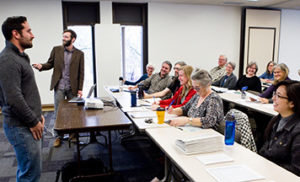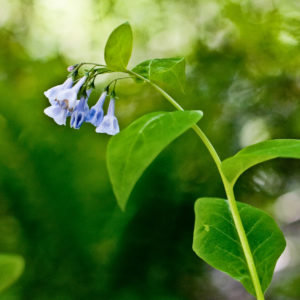Homeowners may be eligible for funding to help boost Rusty Patched Bumblebee population
 Staff from the partner organization Blue Thumb led a Lawns to Legumes workshop at North Regional Library earlier this month. The new state-funded Lawns to Legumes program will help residents convert at least part of their lawn to flowering plants that provide pollinator habitat. Minnesota is home to about 450 native species of bees, many of whose populations are declining. (Photo by Margie O’Loughlin)http://monitorsaintpaul.com/wp-content/uploads/2019/12/Web_Lawns-to-Legumes-02.jpg[/caption]
Staff from the partner organization Blue Thumb led a Lawns to Legumes workshop at North Regional Library earlier this month. The new state-funded Lawns to Legumes program will help residents convert at least part of their lawn to flowering plants that provide pollinator habitat. Minnesota is home to about 450 native species of bees, many of whose populations are declining. (Photo by Margie O’Loughlin)http://monitorsaintpaul.com/wp-content/uploads/2019/12/Web_Lawns-to-Legumes-02.jpg[/caption] By MARGIE O’LOUGHLIN
When the legislative session ended last year, Minnesota was granted something it has never had before: its own state bee.
The Rusty Patched Bumblebee was once among the most widespread of all wild bees seen in the Midwest, but its population nosedived in the early 2000s – it is now listed as an endangered species.
Minnesota is home to a significant number of the remaining Rusty Patched Bumblebees, and many are found in and around the Twin Cities. Bee experts believe homeowners can help this population of wild bees rebuild its numbers, one garden at a time.
At the close of last year’s legislative session, the Minnesota Board of Water and Soil Resources (BWSR) received $900,000 in state funding to develop a three-year pilot program focused on planting residential lawns with pollinator friendly plants. Other states are taking notice of the way Minnesota is funding this community-led program to protect and rebuild its diversity of pollinators.
The funding appropriation is through the Environment and Natural Resources Trust Fund. BWSR worked with local conservation partners throughout the summer to develop program criteria. Funding has been distributed to those partners (primary partners include Metro Blooms and Blue Thumb). Community workshops have begun state-wide, with garden projects slated to be planted in the spring and summer of 2020.
Funding will be targeted in areas benefiting the Rusty Patched Bumblebee and other at-risk species; Minneapolis and St. Paul are in the highest priority area, as are sections of Southeast Minnesota.
Traditional lawns don’t help pollinators much
Dan Shaw is a Senior Ecologist/Vegetation Specialist with the Minnesota Board of Water and Soil Resources. He said, “Bee and other pollinator populations are declining due to habitat loss, pesticide use, introduced parasites, and climate change. With Lawns to Legumes, we’re encouraging residents to transform their yards and gardens into places that support a diversity of wildlife.“
He continued, “Traditional lawns and non-native foundation plantings provide little benefit for pollinators. The idea is to restore natural habitat for wild bees, butterflies, hummingbirds, and a wide range of insect species – all of whom play a critical role in pollinating our food crops and native plants.”
Minnesota residents who have an area that can be used for outdoor planting can apply for a combination of technical assistance (workshops and coaching) and cost-share funding. Shaw anticipates that Lawns to Legumes will provide assistance to about 1,500 people in total.
Renters are also encouraged to participate in increasing pollinator habitat: either by getting permission from property owners to garden, or by planting pollinator friendly plants in pots.
The state’s efforts to provide critical habitat for the Rusty-Patched Bumblebee will also support Minnesota’s other pollinators and wildlife. Participating residents will be asked to provide before and after photos of their yards, and receipts for related expenses if they qualitfy for cost-share funding.
Apply in December
In December 2019, Blue Thumb will begin accepting applications from residents for the first round of individual support as part of the Lawns to Legumes program. Check the Blue Thumb or BWSR websites for updates and applications. Applicants can receive up to $350 of funding through a reimbursement process. Funding decisions will be made and all notifications emailed in February 2020 for spring garden installations.
• 2nd application round will open in March 2020, for summer and fall installations.
• 3rd application round for 2021 plantings may open depending on available funding.
Shaw explained, “In this partnership, BWSR is collaborating with a large group of conservation organizations around the state, as well as municipalities. As a small agency, we don’t have a lot of staff so we’ll be relying on our partners. We’ve been busy training our trainers. They include skilled volunteers in the conservation field like Master Naturalists, Master Water Stewards, Master Gardeners and others who are already well-grounded in environmental education. They’ll be participating in as many as 40 workshops for landowners across the state over the next three years.”
Another important contributor to the Lawns to Legumes program is the Minneapolis College of Art and Design. Students there are developing graphics and messaging for a social media campaign to raise awareness about residential pollinator plantings.
Be part of a movement
Shaw said, “Sometimes I see this more as a movement than a program. Every garden project we fund will have signage, so people can see that homeowners are making a difference.
“There hasn’t been much funding for homeowners to create pollinator habitat before. This is a fantastic opportunity for our conservation partners to collaborate, and to educate the public at the same time.”
 Plant these Top 10
Plant these Top 10
The goal of the Lawns to Legumes program is to create areas of habitat in both urban and rural residential yards that will provide food and shelter for bees and other pollinators. Even small plantings can make a big difference, especially if there are enough of them to provide a matrix or corridor. These are the top 10 plants recommended by Lawns to Legumes to sustain pollinators in Minnesota:
Virginia Bluebell (shown above)
Blazingstar
Golden Rod
Beebalm
Beardtongue
Milkweed
Aster
Wild White Indigo
Red Columbine
Blue Giant Hyssop
Comments
No comments on this item Please log in to comment by clicking here